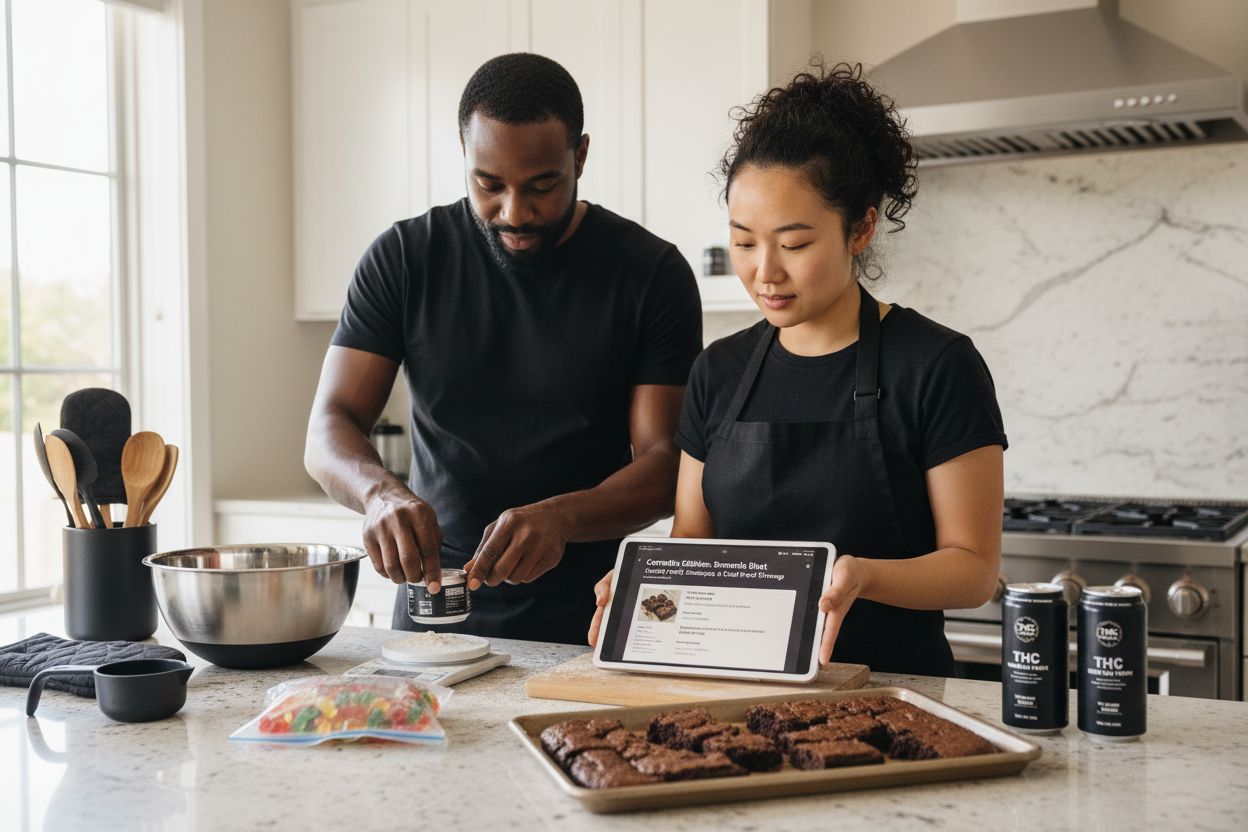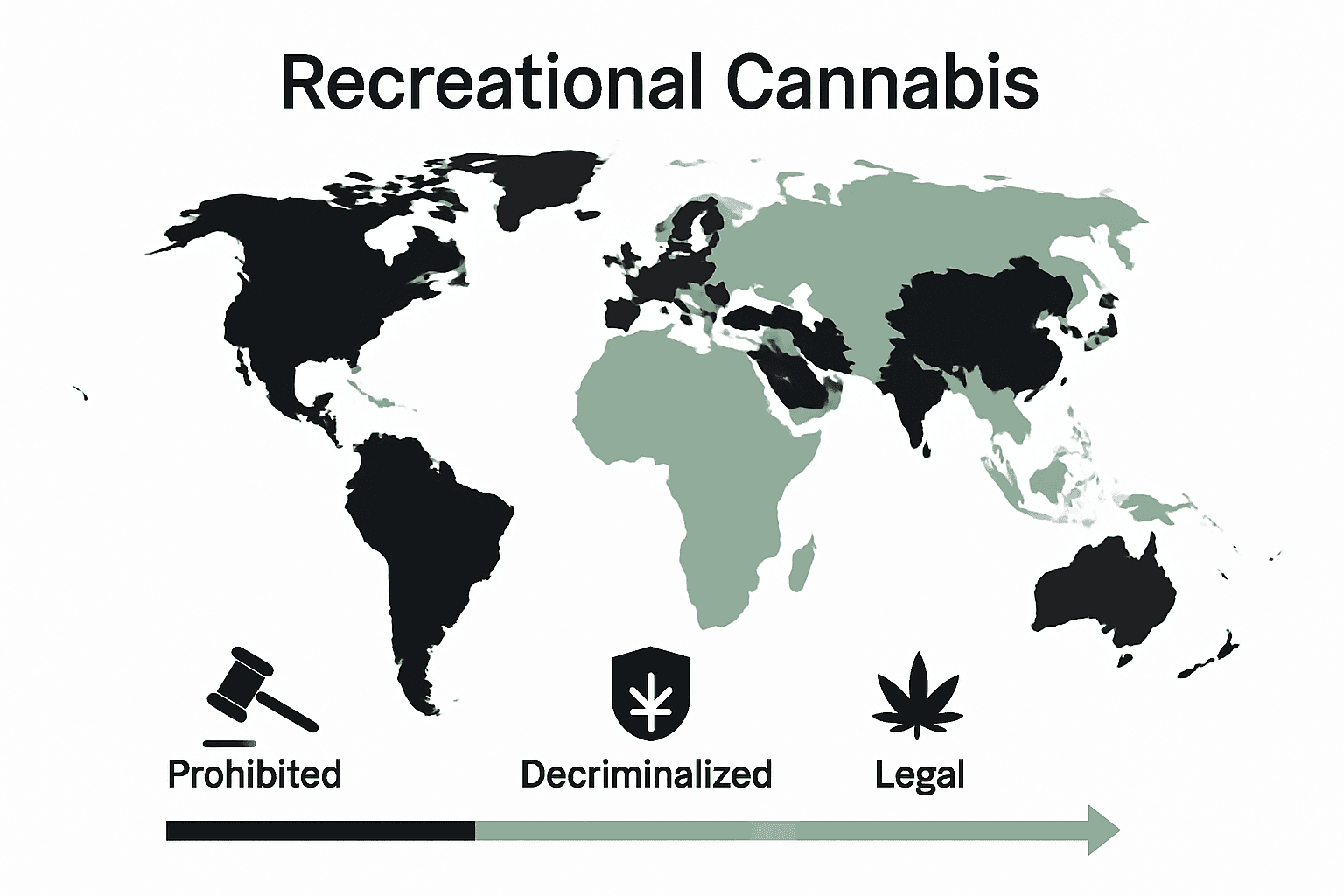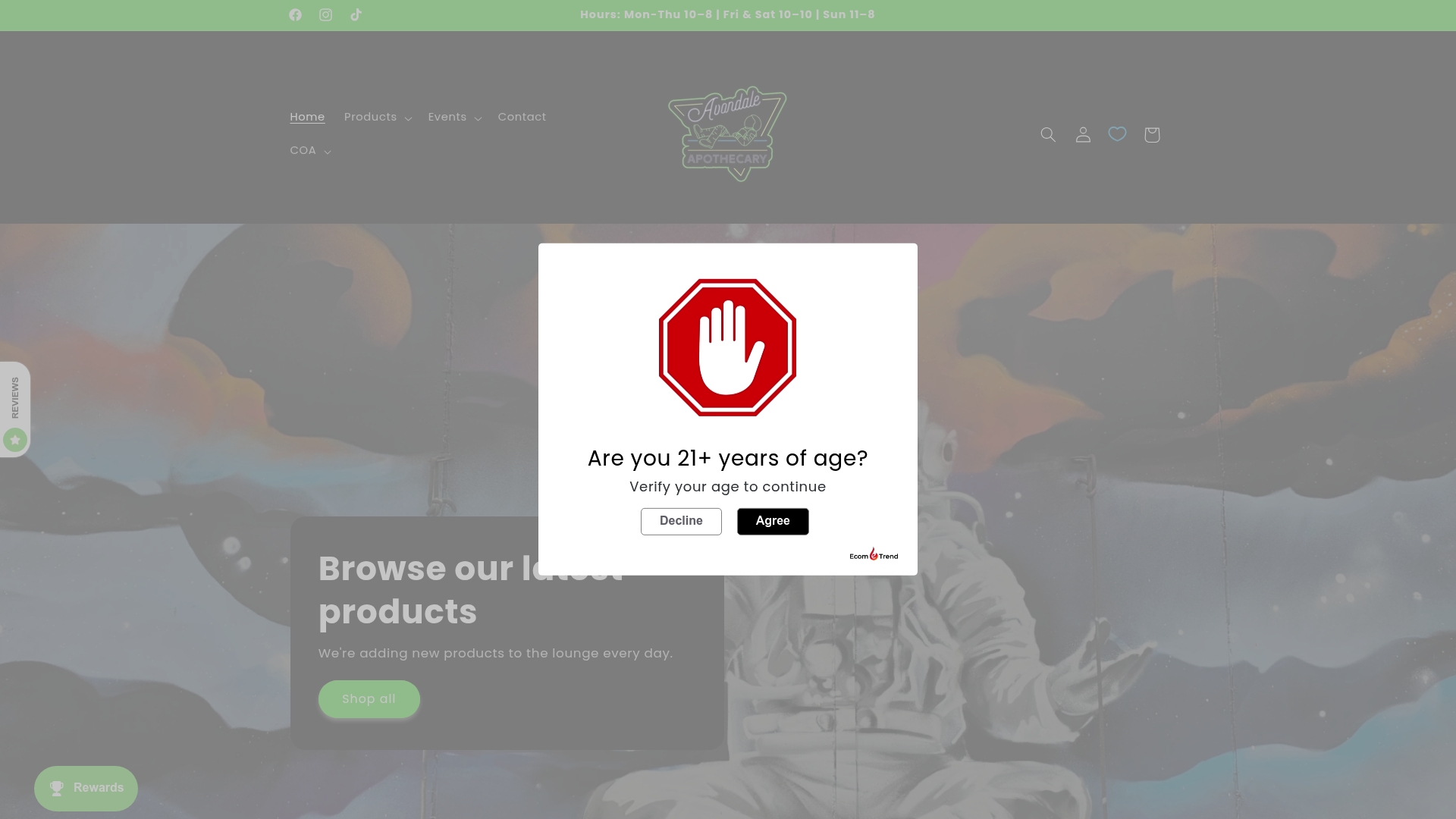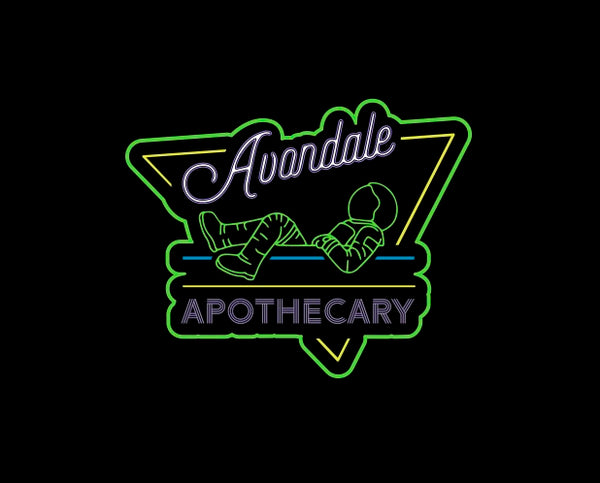Did you know that as many as one in three recreational cannabis users may develop cannabis use disorder? Recreational cannabis is a topic that sparks heated debates and confusion, especially as laws and products change quickly around the world. Whether you are curious about its legal status, health effects, or how to consume it safely, understanding the facts behind common myths can help you make smarter and more responsible choices.
Table of Contents
- Defining Recreational Cannabis And Common Misconceptions
- Types Of Recreational Cannabis Products Explained
- Legal Status And Regulations Worldwide
- How Recreational Cannabis Is Consumed Safely
- Risks, Responsibilities, And Common Mistakes
Key Takeaways
| Point | Details |
|---|---|
| Understanding Cannabis Use | Recreational cannabis is intended for enjoyment, but can lead to cannabis use disorder in 20-33% of users, emphasizing responsible consumption. |
| Diverse Product Types | Recreational cannabis products range from flowers to edibles, concentrates, beverages, and topicals, each offering different effects and consumption methods. |
| Legal Variability | The legality of recreational cannabis varies significantly worldwide; consumers must stay informed about local regulations to ensure compliance. |
| Safety and Responsibility | Safe consumption requires awareness of dosage, methods, and potential risks; users should prioritize responsible practices and secure storage of products. |
Defining Recreational Cannabis and Common Misconceptions
Recreational cannabis represents the intentional consumption of cannabis products for personal enjoyment and non-medical purposes. Unlike medical cannabis, which targets specific health conditions, recreational use focuses on experiencing the plant’s psychoactive effects. According to research from the National Conference of State Legislatures, the legal landscape for recreational cannabis varies dramatically across different jurisdictions, making it critical for consumers to understand local regulations.
A significant misconception surrounding recreational cannabis is the assumption that it is universally harmless. Research published in the National Center for Biotechnology Information reveals that between 20% to 33% of users may potentially develop cannabis use disorder. This statistic challenges the widespread belief that recreational cannabis consumption is without potential risks. Cannabis use disorder can manifest through various health and psychological challenges, suggesting that responsible consumption requires informed decision making.
Common myths about recreational cannabis often include oversimplified narratives about its effects and legal status. Many individuals incorrectly assume that recreational cannabis is legal everywhere or that its consumption has no potential negative consequences. Understanding cannabis flower can help consumers make more educated choices about their recreational experiences. Potential users should prioritize understanding local laws, personal health considerations, and responsible consumption practices.
Ultimately, recreational cannabis represents a complex intersection of personal choice, legal frameworks, and potential health implications. Responsible consumers approach recreational cannabis with knowledge, respect for legal boundaries, and an understanding of potential individual variations in physiological responses.
Types of Recreational Cannabis Products Explained
Recreational cannabis offers diverse product options, each with unique characteristics and consumption methods. According to research from the National Institutes of Health, primary recreational cannabis products include flowers, edibles, concentrates, and topicals, with each type presenting distinct potency levels and consumption experiences. The variety allows consumers to choose products that best match their preferences and desired effects.
Flowers, the most traditional form of cannabis, involve consuming dried plant buds typically through smoking or vaporization. Concentrates represent highly potent cannabis extracts that deliver more intense experiences with smaller quantities. Cannabis beverages offer an alternative consumption method, providing a potentially more controlled and measured approach to recreational use. Learn about cannabis beverages and their unique benefits to understand this emerging product category.
Edibles present a notable category of recreational cannabis products, transforming cannabis into food and drink items. Research from Harvard Health highlights an important caution: edibles can take significantly longer to produce effects compared to smoking, which may lead to potential overconsumption if users are not patient and careful. Typical edible forms include:

- Baked goods
- Gummies
- Chocolates
- Beverages
- Cooking oils
Topicals represent another interesting product type, offering cannabis-infused creams and lotions that can be applied directly to the skin, providing localized effects without psychoactive experiences. Understanding the nuanced differences between these product types empowers consumers to make informed, responsible choices aligned with their personal preferences and wellness goals.
Here’s a comparison of common recreational cannabis product types:
| Product Type | Main Characteristics | Common Consumption Methods |
|---|---|---|
| Flower | Dried cannabis buds Traditional form |
Smoking Vaporizing |
| Edible | Food or drink infused Delayed effects |
Baked goods Gummies Chocolates Beverages |
| Concentrate | Highly potent extracts Stronger effects |
Dabbing Vaporizing |
| Beverage | Drinkable form Measured dosing |
Ready-to-drink Mix additives |
| Topical | Applied to skin No psychoactive effect |
Creams Lotions |
Legal Status and Regulations Worldwide
Recreational cannabis legality represents a complex and rapidly evolving global landscape, with significant variations across different countries and regions. According to research published in international medical journals, the legal approach to cannabis ranges from complete prohibition to full legalization, creating a nuanced regulatory environment that consumers must carefully navigate.
In North America, the United States presents a unique regulatory scenario where legalization occurs at the state level, resulting in a diverse patchwork of laws and regulations. Some states have fully legalized recreational cannabis, while others maintain strict prohibitions. Canada stands out as a pioneering nation, having fully legalized recreational cannabis nationwide, establishing a comprehensive regulatory framework that other countries are now studying. Explore the safety considerations of cannabis edibles to understand the importance of responsible consumption within these legal frameworks.
Globally, the legal status varies dramatically. Countries like Uruguay have taken progressive steps by fully legalizing recreational cannabis, while others like the Netherlands have adopted a policy of tolerance, allowing controlled consumption in specific settings. European countries demonstrate particularly complex approaches:
- Germany permits medical cannabis under strict regulations
- The Netherlands tolerates limited recreational use
- Spain allows private cannabis clubs
- Portugal has decriminalized personal possession
These varied legal approaches underscore the importance of understanding local regulations before engaging with recreational cannabis. Consumers must remain informed about current laws, potential legal risks, and the specific regulatory nuances in their jurisdiction to ensure responsible and legal consumption.

How Recreational Cannabis Is Consumed Safely
Safe cannabis consumption requires a thoughtful and responsible approach, prioritizing personal health and legal compliance. According to guidance from public health experts, the key to responsible recreational cannabis use involves understanding dosage, consumption methods, and potential risks. Consumers must be proactive in educating themselves about proper usage and potential impacts on their physical and mental well-being.
Dosage and initial consumption are critical aspects of safe cannabis use. Research from Harvard Health recommends starting with low doses, particularly for edibles, which can have a delayed and potentially more intense effect. Check out our safety tips for cannabis edibles to understand the nuanced approach to responsible consumption. Important safety guidelines include:
- Start with minimum recommended dosages
- Wait at least 2 hours between consumption attempts
- Avoid mixing cannabis with alcohol or other substances
- Store products securely away from children and pets
- Never operate vehicles or machinery while under the influence
Alternative consumption methods can also mitigate potential health risks. Avoiding traditional smoking and opting for methods like tinctures, edibles, or vaporization can reduce respiratory complications. Additionally, purchasing cannabis from legal, regulated sources ensures product quality and safety standards. Understanding personal tolerance, maintaining a controlled environment, and being aware of potential interactions with existing medications are crucial steps in ensuring a safe and enjoyable recreational cannabis experience.
Risks, Responsibilities, and Common Mistakes
Recreational cannabis consumption involves significant personal and social responsibilities that extend far beyond simply choosing a product. Research indicates that users must carefully navigate potential risks, understanding that cannabis can substantially impact personal safety and broader community well-being. Impaired judgment and coordination represent critical concerns that demand proactive management and self-awareness.
Common mistakes often stem from underestimating cannabis’s potency and potential effects. What are Cannabis Vapes? Understanding Their Use and Benefits can help consumers better comprehend consumption nuances. The most prevalent errors include:
- Overconsumption, particularly with edibles
- Driving or operating machinery while impaired
- Sharing products with minors
- Improper storage of cannabis products
- Mixing cannabis with alcohol or other substances
Parental and community responsibilities cannot be overstated. Medical research highlights a concerning trend of unintentional cannabis ingestion by children, with increased legalization correlating to higher emergency department visits. Secure storage isn’t just a recommendation—it’s a critical safety imperative. Users must treat cannabis products like any other potentially harmful substance, keeping them in locked, child-resistant containers far from potential access by children or pets. Responsible consumption means understanding not just personal limits, but also potential broader impacts on family and community safety.
Discover Safe and Enjoyable Recreational Cannabis with Avondale Apothecary
Navigating the world of recreational cannabis can feel overwhelming with all the choices and safety concerns. This article highlights key challenges like understanding product types, safe consumption practices, and legal responsibilities. You might be wondering how to find high-quality products that come with transparency and trustworthy information. At Avondale Apothecary, we address these exact concerns by offering a curated lineup of premium cannabis strains, edibles, concentrates, and infusion beverages backed by comprehensive Certificates of Analysis. Our goal is to give you the confidence to enjoy recreational cannabis responsibly while respecting your personal health and local laws.

Start your journey with a reliable partner by exploring our full range of products at Avondale Apothecary. Whether you want to learn more about specific options like cannabis edibles or need guidance on safe consumption, we provide detailed listings and expert insights to support your choices. Take control of your recreational experience now by visiting Avondale Apothecary. Your safe and informed cannabis adventure begins here.
Frequently Asked Questions
What is recreational cannabis?
Recreational cannabis refers to the intentional use of cannabis products for personal enjoyment rather than for medical purposes. It is consumed primarily for its psychoactive effects.
What are the common types of recreational cannabis products?
Common types include flowers (dried cannabis buds), edibles (food and drink items), concentrates (highly potent cannabis extracts), beverages (drinkable cannabis), and topicals (applied to the skin).
How should I safely consume recreational cannabis?
To consume cannabis safely, start with a low dose, especially for edibles. Wait at least two hours between doses, avoid mixing with alcohol, and ensure products are stored securely away from children and pets.
What are the potential risks of using recreational cannabis?
Potential risks include developing cannabis use disorder, impaired judgment and coordination, and the dangers of overconsumption, particularly with edibles. Responsible use and understanding personal limits are vital.

